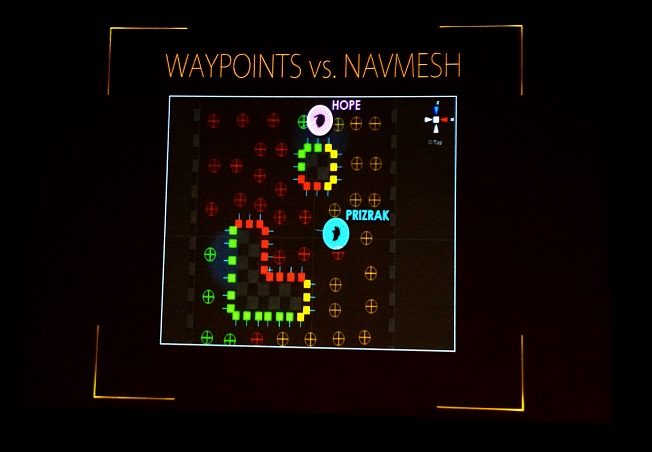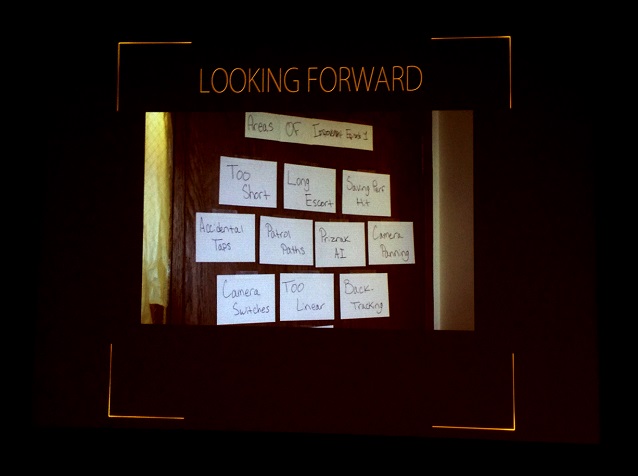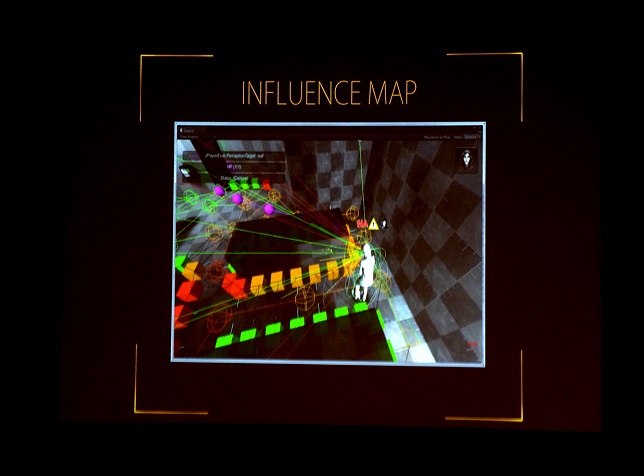One of my favorite games released last year was Camouflaj's Republique: Episode I: Exordium for iOS, a game that merged tropes of survival horror and tactical stealth to generate what creative lead Ryan Payton calls a "stealth, survival action game." In the game you play a hacker using a cell phone to help a young girl named Hope escape a fascist society. The game, which was funded by Kickstarter and featured an A-list voice cast with the likes of David Hayter and Jennifer Hale, had a strong media push and positive Kickstarter updates throughout development.
So it was fascinating to hear Payton and fellow Camouflaj developer Greg Raab's talk at GDC, titled "500 Days of Failure: Designing Republique's 'One Touch' Gameplay," since from their positive media push I never knew they were in any trouble. Payton began almost immediately with a brief exposé on how for 500 of the 600 days of development the primary mechanic they had been trying to sell the game on just didn't work. How the game failed to come together, and the solutions they discovered, is a great example of creative problem solving in game development.
A big part of Republique's one-touch design philosophy was born out of frustration. He would take the triple-A games he had worked on home (MGS4 and Halo 4) and wanted to share them with his friends and family. However, it was very difficult for them, as non-gamers, to navigate a seventeen-button controller. He wanted to provide the triple-A experience on a ubiquitous format and picked iOS due to its high degree of saturation and uniform distribution across multiple cultures. He used Chair's Infinity Blade as an example of what could be done with the format.
In the game you play as an as-yet-unnamed individual who moves from security cam to security cam using Hope's cellphone to propel you from one hacking objective to another. You help Hope by hacking doors, computers, phones, etc, and giving her directions on where and when to move. However, Hope is designed to be her own character, with her own decisions on how she moves.
In the prototyping phase against pre-rendered backgrounds, they were able to get a look that they wanted, which turned out similar to Resident Evil in terms of style, though this quickly fell into a stealth gameplay mechanic that was centered heavily about avoiding detection. After the Kickstarter's success, the complications were almost immediate. The pre-rendered backgrounds would be too costly in terms of space and resources for high-resolution devices they had promised them for, like the iPad, prompting them to adopt 3D architecture in Unity. Still, there were successes using single touches to move the player's view from one security camera to another or automatically jump to the next camera when Hope left the area. There were other issues, though.
Combat didn't work. Payton wanted to create a timing mini-game where Hope would have to wait for the guard, then attack when the player directed at just the right moment. However, this was at odds with another aspect of their design philosophy, that the player doesn't have direct control over Hope, just elements of her environment and giving her prompts on where to move. Hope, as an AI, picks the path that is the least dangerous to get there.

Since Hope was supposed to be an autonomous character, she was designed to avoid detection by guards automatically. Here Payton threw up some images of the Influence Map and Waypoints vs. NavMesh for Hope's AI navigation in a room; the green blocked areas are safe, yellow is where Hope will be spotted if she stands up, and red is where she will definitely be spotted by a guard (Prizrak). In a short video, these areas dynamically changed with Hope hugging the shifting green areas behind cover as a guard moved on the opposite side of the cover surrounded by red blocks. Since Hope was designed to avoid detection, having her stay in one place when the guards attacked was directly against the basic character programming.
One fix for this that they tried was having the player click on Hope when they wanted her to stop for combat. However, this created new problems. With Hope being clickable, if there was something behind her they wanted her to interact with, it was negated by the hitbox they had set up for the player's finger: Instead of clicking behind Hope, they clicked on her.
But these problems were simple compared to the most basic issue that the one-touch gameplay didn't work. Some of this was due to elements they didn't expect; particularly a small subset of two-player types, what Payton and Raab called "Diablo Clickers" and "Lazy Tappers." The Diablo Clickers would spam-click the screen in order to try to get Hope to move faster, and Lazy Tappers would tap and then slightly drag their finger across the screen—dragging a finger across the screen, deliberately, moves Republique's camera—so for a small set of players they were constantly moving the camera when they simply meant to click.
Another issue was that Payton wanted to eliminate all buttons from the game's interface; since it was his goal to get away from a virtual-controller mentality that many trying to create triple-A style games on phones attempt. However, without buttons there were significant problems. How do you access Hope's inventory? How do you switch from the real-time view of the world to the hacker world (where you can hack things in the environment) Omniview?
One solution they tried was to have the player swipe down from the top of the screen to enter Omniview, which worked in concept. However, on iOS swiping from the top of the screen opens the device's Notification Center. This created all kinds of problems for the devs. In the midst of all these game-breaking problems, Payton went to LA to do voice recordings for the game.
Upon his return he and his team did something extraordinary. They changed their whole design philosophy. Since most of them had come from the triple-A space, with them having worked on games like Halo, they were used to the idea of training the player that certain functions mapped to certain buttons. Instead of doing that; trying to teach the player how to play in a way that wasn't intuitive, they watched how the players actually played, then adjusted their game accordingly.

This is a philosophical shift that seems to be prevalent in a lot of games where triple-A devs have left those spaces to work on smaller scale projects; or projects that are publicly funded. Instead of a corporate overlord, the player is your boss; it's to their specifications that your game has to match up.
Rather than try to stop the Lazy Tappers and Diablo Clickers from playing the way they did, they compensated for it. Camouflaj created code that ignored multiple taps, and that wouldn't recognize the swipe of a "lazy tap," allowing these players to get the same enjoyment as others. They dropped the time-based combat for a simpler mechanic and replaced the swiping to go into Omniview with a single button on the interface (and buttons while in Omniview for elements like inventory and collectibles). This meant giving up on the purity of the idea of "one touch" while remaining true to the philosophy of it.
What emerged, Republique: Episode 1: Exordium, is a great game, but for that last 100 days it almost wasn't. As Camouflaj looks towards Episode 2, they aren't resting on their laurels, either. For one of his final slides Payton put up a picture of 3x5s on the studio door of "Areas of Improvement" from Episode 1. Considering that the game costs for $4.99 on the app store, Camouflaj is working to give you more than your money's worth.










